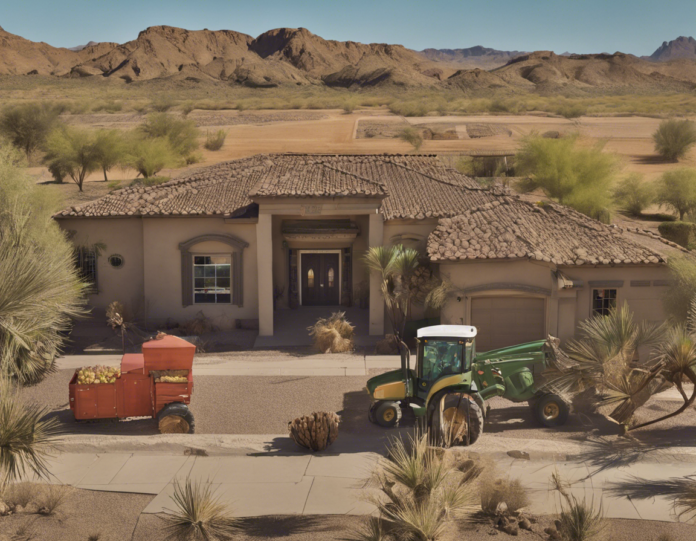The town of Casa Grande, located in Pinal County, Arizona, is a hidden gem for agricultural enthusiasts and history buffs alike. Casa Grande, which means “big house” in Spanish, is aptly named for its rich heritage and abundant harvests that have sustained the community for generations. Let’s delve into the agricultural wonders and historical significance of Casa Grande to unearth the treasures that this charming town has to offer.
History of Casa Grande
Casa Grande boasts a long and fascinating history that dates back over a thousand years. The centerpiece of this history is the Casa Grande Ruins National Monument, which showcases the remnants of an ancient Hohokam farming community. The centerpiece of this monument is the Casa Grande, or “Great House,” a four-story structure built by the Hohokam people around 1350 AD. This architectural marvel, constructed with caliche mud and wooden beams, serves as a testament to the ingenuity and craftsmanship of its builders.
The Hohokam people were skilled farmers who utilized an intricate network of irrigation canals to cultivate corn, beans, squash, and other crops in the arid desert landscape. Their agricultural practices were advanced for their time and laid the foundation for the fertile farmlands that characterize Casa Grande today.
Agricultural Marvels of Casa Grande
1. Cotton Farming
Casa Grande is renowned for its cotton farming industry, which thrives in the region’s sunny climate and fertile soil. Cotton fields stretch across the landscape, painting the town in a sea of white during the harvest season. The cotton gin, a machine that separates cotton fibers from their seeds, plays a crucial role in processing the harvested cotton for various uses.
2. Pecan Orchards
Pecan orchards grace the outskirts of Casa Grande, offering a picturesque sight against the backdrop of the desert mountains. Pecans are a valuable crop in Casa Grande, prized for their rich flavor and nutritional benefits. The pecan harvest season in Casa Grande typically occurs in the fall, when the trees yield bountiful crops of delicious nuts.
3. Citrus Groves
Citrus groves thrive in the mild winters and hot summers of Casa Grande, producing a variety of fruits such as oranges, lemons, and grapefruits. The citrus harvest season, which peaks in late winter and early spring, showcases the vibrant colors and fragrant aromas of ripe citrus fruits ready for picking.
4. Alfalfa Fields
Alfalfa is a key crop in Casa Grande’s agricultural industry, valued for its nutrient-rich feed for livestock. Alfalfa fields carpet the countryside, providing a vital source of sustenance for cattle and other animals. The alfalfa harvest season is a busy time in Casa Grande, as farmers work to gather and store this valuable crop for animal consumption.
Farming Practices and Sustainability
Farming in Casa Grande is not just about reaping bountiful harvests; it also emphasizes sustainability and environmental stewardship. Many farmers in Casa Grande employ organic farming practices, eschewing chemical fertilizers and pesticides in favor of natural methods that promote soil health and biodiversity. Crop rotation is another common practice in Casa Grande, helping to maintain soil fertility and prevent pest infestations.
The use of drip irrigation systems is prevalent in Casa Grande, allowing farmers to efficiently water their crops while minimizing water wastage. Drip irrigation delivers water directly to the plant roots, reducing evaporation and runoff compared to traditional overhead irrigation methods.
The Farmer’s Market Experience
Visiting the Casa Grande Farmers Market is a delightful way to immerse yourself in the agricultural abundance of the region. The market showcases a vibrant array of fresh produce, artisanal foods, handmade crafts, and local products that reflect the diverse agricultural heritage of Casa Grande. From farm-fresh fruits and vegetables to homemade jams and baked goods, the market offers a cornucopia of treasures for visitors to enjoy.
Engaging with local farmers and artisans at the market provides a unique opportunity to learn about the farming practices, culinary traditions, and cultural heritage that define Casa Grande. You can savor the flavors of the region, sample unique food creations, and take home a piece of Casa Grande’s agricultural legacy.
Exploring Agricultural Tourism in Casa Grande
Agricultural tourism is a growing trend in Casa Grande, as visitors seek immersive experiences that connect them with the land, the farmers, and the harvests of the region. Farm tours offer a behind-the-scenes look at the daily operations of local farms, allowing guests to witness the harvesting process, interact with farm animals, and even participate in hands-on activities such as fruit picking or hayrides.
Agricultural festivals are popular events in Casa Grande, celebrating the seasonal harvests and showcasing the culinary delights of the region. From citrus festivals to pecan fairs, these gatherings offer a feast for the senses, with live music, food tastings, cooking demonstrations, and family-friendly activities that highlight the agricultural richness of Casa Grande.
Protecting Agricultural Heritage in Casa Grande
Preserving Casa Grande’s agricultural heritage is paramount to ensuring the sustainability and prosperity of the region for future generations. Farmland preservation initiatives aim to safeguard agricultural lands from urban sprawl and commercial development, preserving open spaces and productive farmlands for agricultural use.
Educational programs that promote farm-to-table connections, sustainable farming practices, and environmental conservation play a vital role in raising awareness about the importance of agriculture in Casa Grande. By engaging with local schools, community organizations, and policymakers, these programs help instill a sense of appreciation for the agricultural roots of Casa Grande and inspire future generations to steward the land responsibly.
Frequently Asked Questions (FAQs):
1. What is the climate like in Casa Grande?
Casa Grande has a desert climate, characterized by hot summers, mild winters, and low humidity. The region receives minimal rainfall, with most precipitation occurring during the monsoon season in the summer.
2. What crops are grown in Casa Grande?
Crops grown in Casa Grande include cotton, pecans, citrus fruits, alfalfa, wheat, and melons. These crops thrive in the region’s fertile soil and sunny climate.
3. How important is agriculture to the economy of Casa Grande?
Agriculture plays a significant role in the economy of Casa Grande, providing jobs, income, and sustenance for the community. The agricultural industry also supports related sectors such as food processing, transportation, and tourism.
4. Can visitors participate in farm activities in Casa Grande?
Yes, visitors can participate in farm tours, fruit picking, and agricultural festivals in Casa Grande. These activities offer a hands-on experience of farm life and allow guests to engage with the agricultural heritage of the region.
5. What are some popular agricultural festivals in Casa Grande?
Popular agricultural festivals in Casa Grande include the Citrus Festival, Pecan Fair, and Cotton Harvest Celebration. These festivals showcase the seasonal harvests of the region and feature food tastings, live entertainment, and educational exhibits.
In conclusion, Casa Grande stands as a testament to the enduring legacy of agriculture in shaping communities and landscapes. From the ancient farming practices of the Hohokam people to the modern-day cotton fields and citrus groves that flourish in the region, Casa Grande exudes a rich tapestry of agricultural heritage waiting to be explored. By embracing sustainable farming practices, supporting local farmers, and engaging in agritourism experiences, visitors can gain a deeper appreciation for the bountiful harvests and cultural treasures of Casa Grande.









